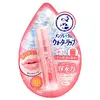What's inside
What's inside
 Key Ingredients
Key Ingredients

 Benefits
Benefits

 Concerns
Concerns

 Ingredients Side-by-side
Ingredients Side-by-side

Cetyl Ethylhexanoate
EmollientPolyethylene
AbrasiveDiisostearyl Malate
EmollientPetrolatum
EmollientLanolin
EmollientC10-30 Cholesterol/Lanosterol Esters
EmulsifyingEthylhexyl Methoxycinnamate
UV AbsorberMicrocrystalline Wax
Emulsion StabilisingSodium Hyaluronate
HumectantSoluble Collagen
HumectantAloe Barbadensis Leaf Extract
EmollientHoney
HumectantCocos Nucifera Oil
MaskingParaffinum Liquidum
EmollientHydrolyzed Hyaluronic Acid
HumectantWater
Skin Conditioning1,2-Hexanediol
Skin ConditioningDipropylene Glycol
HumectantButyl Methoxydibenzoylmethane
UV AbsorberPolyglyceryl-4 Oleate
EmulsifyingPolyglyceryl-6 Ricinoleate
EmulsifyingAlumina
AbrasiveDimethicone
EmollientMica
Cosmetic ColorantCI 77492
Cosmetic ColorantTitanium Dioxide
Cosmetic ColorantCI 45380
Cosmetic ColorantCetyl Ethylhexanoate, Polyethylene, Diisostearyl Malate, Petrolatum, Lanolin, C10-30 Cholesterol/Lanosterol Esters, Ethylhexyl Methoxycinnamate, Microcrystalline Wax, Sodium Hyaluronate, Soluble Collagen, Aloe Barbadensis Leaf Extract, Honey, Cocos Nucifera Oil, Paraffinum Liquidum, Hydrolyzed Hyaluronic Acid, Water, 1,2-Hexanediol, Dipropylene Glycol, Butyl Methoxydibenzoylmethane, Polyglyceryl-4 Oleate, Polyglyceryl-6 Ricinoleate, Alumina, Dimethicone, Mica, CI 77492, Titanium Dioxide, CI 45380
Beeswax
Emulsion StabilisingDimethicone
EmollientPetrolatum
EmollientHydrogenated Poly(C6-14 Olefin)
EmollientPhenyl Trimethicone
Skin ConditioningButyrospermum Parkii Butter
Skin ConditioningTrimethylpentanediol/Adipic Acid/Glycerin Crosspolymer
Skin ConditioningPrunus Cerasus Seed Oil
EmollientHydrogenated Polyisobutene
EmollientAroma
Polysilicone-11
Tocopheryl Acetate
AntioxidantSodium Saccharin
MaskingEthylene/Propylene/Styrene Copolymer
Butylene/Ethylene/Styrene Copolymer
Pentaerythrityl Tetra-Di-T-Butyl Hydroxyhydrocinnamate
AntioxidantBeeswax, Dimethicone, Petrolatum, Hydrogenated Poly(C6-14 Olefin), Phenyl Trimethicone, Butyrospermum Parkii Butter, Trimethylpentanediol/Adipic Acid/Glycerin Crosspolymer, Prunus Cerasus Seed Oil, Hydrogenated Polyisobutene, Aroma, Polysilicone-11, Tocopheryl Acetate, Sodium Saccharin, Ethylene/Propylene/Styrene Copolymer, Butylene/Ethylene/Styrene Copolymer, Pentaerythrityl Tetra-Di-T-Butyl Hydroxyhydrocinnamate
 Reviews
Reviews

Ingredients Explained
These ingredients are found in both products.
Ingredients higher up in an ingredient list are typically present in a larger amount.
Dimethicone is a type of synthetic silicone created from natural materials such as quartz.
What it does:
Dimethicone comes in different viscosities:
Depending on the viscosity, dimethicone has different properties.
Ingredients lists don't always show which type is used, so we recommend reaching out to the brand if you have questions about the viscosity.
This ingredient is unlikely to cause irritation because it does not get absorbed into skin. However, people with silicone allergies should be careful about using this ingredient.
Note: Dimethicone may contribute to pilling. This is because it is not oil or water soluble, so pilling may occur when layered with products. When mixed with heavy oils in a formula, the outcome is also quite greasy.
Learn more about DimethiconePetrolatum is more commonly known as petroleum jelly. It is created by mixing waxes and mineral oils.
This ingredient is effective at reducing water loss by 99%. This is because it is an occlusive. Occlusives create a hydrophobic barrier on the skin to prevent evaporation. This property makes it great for hydrating dry skin.
Pro tip: Use occlusives, such as this ingredient, on damp skin for the best results.
The quality or origin of petrolatum is only known when disclosed by the brand. Most cosmetic petrolatum has gone through several purification stages.
Another benefit of occlusives is it protects your skin against infection or allergies.
Petrolatum may not be safe for fungal-acne. Studies show mineral oil / petroleum leads to the growth of M. Furfur, a type of yeast.
Learn more about Petrolatum